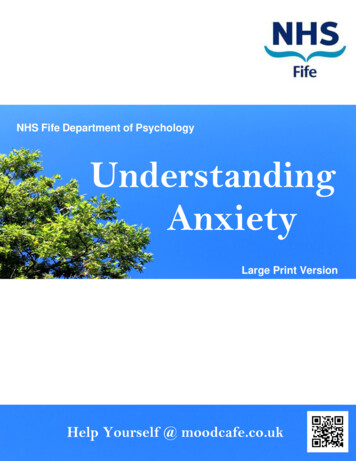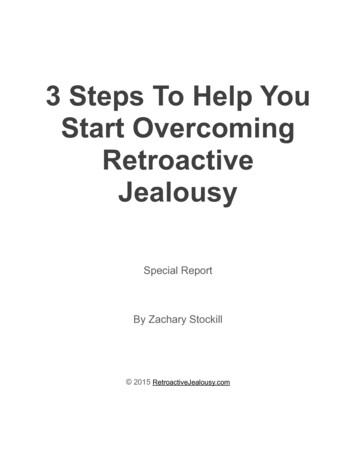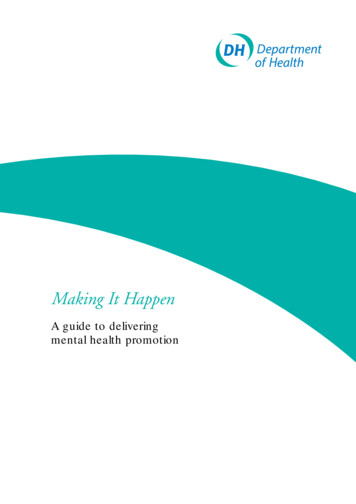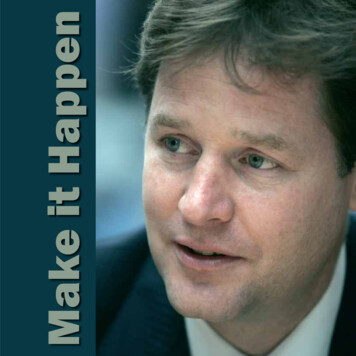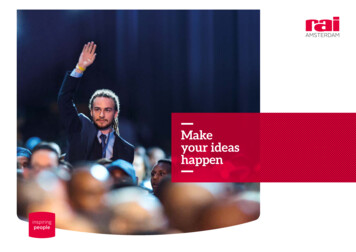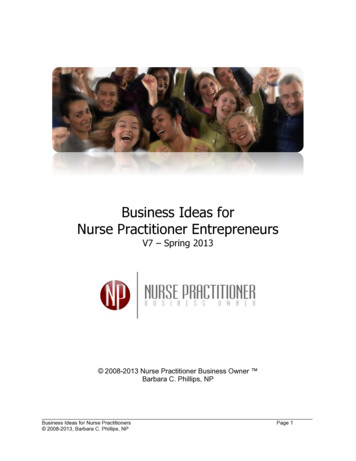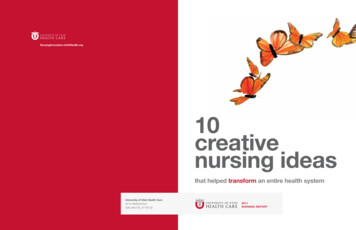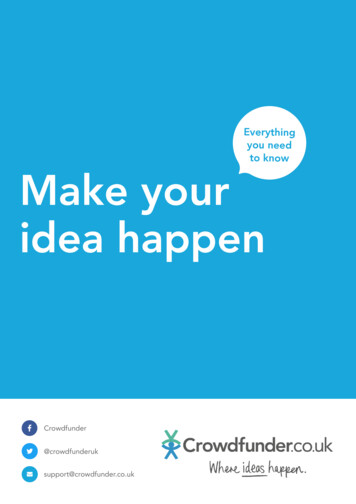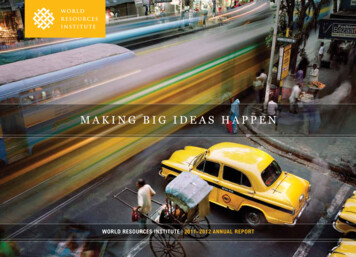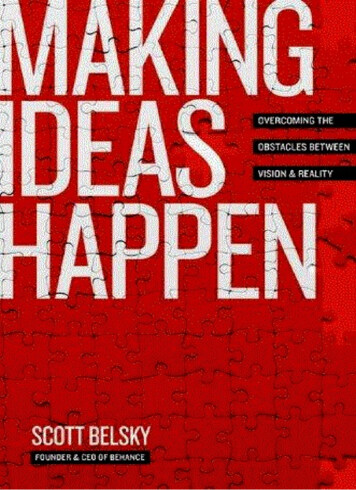
Transcription
Table of ContentsTitle PageCopyright PageDedicationIntroductionPart 1 - ORGANIZATION AND EXECUTIONTHE COMPETITIVE ADVANTAGE OF ORGANIZATIONTHE ACTION METHOD: - Work and Life with a Bias Toward ActionPRIORITIZATION: - Managing Your Energy Across Life’s ProjectsEXECUTION: - Always Moving the Ball ForwardMENTAL LOYALTY: - Maintaining Attention and ResolvePart 2 - THE FORCES OF COMMUNITYHARNESSING THE FORCES AROUND YOUPUSHING IDEAS OUT TO YOUR COMMUNITYPart 3 - LEADERSHIP CAPABILITYTHE REWARDS OVERHAULTHE CHEMISTRY OF THE CREATIVE TEAMMANAGING THE CREATIVE TEAMSELF-LEADERSHIPAN OPPORTUNITY AND A RESPONSIBILITYAcknowledgementsAppendix 1: - Tips for Practicing the Action MethodAppendix 2: - The Purple Santa ExperimentAppendix 3: - Overview of the Behance NetworkIndexAbout the Author
PORTFOLIOPublished by the Penguin GroupPenguin Group (USA) Inc., 375 Hudson Street, New York, New York 10014, U.S.A.Penguin Group (Canada), 90 Eglinton Avenue East, Suite 700, Toronto, Ontario,Canada M4P 2Y3(a division of Pearson Penguin Canada Inc.)Penguin Books Ltd, 80 Strand, London WC2R 0RL, EnglandPenguin Ireland, 25 St. Stephen’s Green, Dublin 2, Ireland (a division of Penguin BooksLtd)Penguin Books Australia Ltd, 250 Camberwell Road, Camberwell, Victoria 3124,Australia(a division of Pearson Australia Group Pty Ltd)Penguin Books India Pvt Ltd, 11 Community Centre, Panchsheel Park, New Delhi - 110017, IndiaPenguin Group (NZ) , 67 Apollo Drive, Rosedale, North Shore 0632, New Zealand(a division of Pearson New Zealand Ltd)Penguin Books (South Africa) (Pty) Ltd, 24 Sturdee Avenue, Rosebank, Johannesburg2196,South AfricaPenguin Books Ltd, Registered Offices:80 Strand, London WC2R ORL, EnglandFirst published in 2010 by Portfolio,a member of Penguin Group (USA) Inc.Copyright Behance, LLC, 2010All rights reservedPhotographs on page 95 used by permission of Colin Williams.LIBRARY OF CONGRESS CATALOGING-IN-PUBLICATION DATABelsky, Scott.Making ideas happen : overcoming the obstacles between vision and reality / ScottBelsky.p. cm.Includes index.eISBN: 97811014287641. Creative ability in business. 2. Success in business. 3. Leadership. I. Title.HD53.B.4’09—dc22 2009041911Without limiting the rights under copyright reserved above, no part of this publicationmay be reproduced, stored in or introduced into a retrieval system, or transmitted, in anyform or by any means (electronic, mechanical, photocopying, recording or otherwise),without the prior written permission of both the copyright owner and the above publisherof this book.The scanning, uploading, and distribution of this book via the Internet or via any othermeans without the permission of the publisher is illegal and punishable by law. Pleasepurchase only authorized electronic editions and do not participate in or encourageelectronic piracy of copyrightable materials. Your support of the author’s rights isappreciated.While the author has made every effort to provide accurate telephone numbers andInternet addresses at the time of publication, neither the publisher nor the authorassumes any responsibility for errors, or for changes that occur after publication. Further,publisher does not have any control over and does not assume any responsibility forauthor or third-party Web sites or their content.
http://us.penguingroup.com
To Nancy and Mark,with gratitude for theprecious opportunityof endless possibility
INTRODUCTION:Making Ideas HappenIDEAS DON’T HAPPEN because they are great—or by accident. The misconceptionthat great ideas inevitably lead to success has prevailed for too long. Whether you havethe perfect solution for an everyday problem or a bold new concept for a creativemasterpiece, you must transform vision into reality. Far from being some stroke ofcreative genius, this capacity to make ideas happen can be developed by anyone. Youjust need to modify your organizational habits, engage a broader community, anddevelop your leadership capability.This book aims to take pie-in-the-sky notions of how the creative process unfolds andbring them down to earth. Creative people are known for winging it: improvising andacting on intuition is, in some way, the haloed essence of what we do and who we are.However, when we closely analyze how the most successful and productive creatives,entrepreneurs, and businesspeople truly make ideas happen, it turns out that “having theidea” is just a small part of the process, perhaps only 1 percent of the journey.Thomas Edison once famously quipped, “Genius is 1 percent inspiration and 99percent perspiration.” For the creative mind, inspiration comes easily. But what makesup the other 99 percent of making ideas happen? Read on for a surprisingly pragmaticset of insights and tips that have emerged from over six years spent studying thebehaviors and skill sets of those who make their ideas happen again and again.A QUICK PRIMER:Making Your Ideas HappenIn the sections ahead, we will discuss the methods behind spectacular achievements—ideas that have overcome the odds and become realities. But before we do, here’sa primer on a few terms I use throughout the book and some assumptions I makeabout you (and your ideas)!You have ideas that you want to make happen. Whatever your business orindustry, success is dependent on developing and executing new ideas. We’re notjust talking about new products, new business ideas, or your vision for the next greatAmerican novel. You likely come up with creative solutions to problems every day.Unfortunately, regardless of how great your ideas may be, most of them will neverhappen. Most ideas get lost in what I call the “project plateau,” a period of intenseexecution where your natural creative tendencies turn against you. As a leader in yourindustry (and the leader of your life), you must learn to defy these tendencies.You can develop the capacity to make ideas happen. From years ofresearching creative individuals and teams, I will share the practices used to makeideas happen, time and time again.Making ideas happen Ideas Organization Communal forces Leadership capability. There is a framework for all of the insights and methods wewill discuss. Aside from generating ideas (which we will not discuss), the capacity tomake ideas happen is a combination of the forces of organization, community, andleadership. We will dive into each of these forces and discuss how you should usethem in your own creative pursuits.Organization enables you to manage and ultimately execute your ideas. Inthe modern world of information overload and constant connectivity, you must manageyour energy wisely. Otherwise, you will fall into a state of “reactionary work flow,”where you act impulsively (rather than proactively) and simply try to stay afloat.Everything in life should be approached as a project. Every project can be brokendown into just three things: Action Steps, Backburner Items, and References. The“Action Method,” which we will discuss in the first section of the book, is a compositeof the best practices for productivity shared by creative leaders. The Action Methodhelps those of us with creative tendencies live and work with a bias toward action.With an understanding of this methodology, we will delve deeply into prioritization,managing your energy and attention, and fully executing your ideas.
The forces of community are invaluable and readily available. Ideas don’thappen in isolation. You must embrace opportunities to broadcast and then refineyour ideas through the energy of those around you. In the second section of this book,we will break down the communal forces that cause ideas to gain traction.Fruitful innovation requires a unique capacity to lead. Leading any sort ofcreative pursuit requires an overhaul of how we motivate others and ourselves. Themost admired leaders are able to build and manage teams that can overcome theobstacles faced in creative projects. There is also a mind-set we must achieve towithstand (and capitalize on) the doubts and pressures we face along the way.While the tendency to generate ideas is rather natural, the path to making themhappen is tumultuous. This book is intended to outfit you with the methods andinsights that build your capacity to defy the odds and make your ideas happen.
Making This Book HappenI have always been a bit frustrated with creativity. I would get impatient watchingcolleagues and friends come up with great ideas, only to become distracted by otherideas and the general demands of life. I found the poor odds that anyone would actuallyfollow through with an idea very upsetting. After a series of jobs and a graduate degree,my frustration turned into fascination and subsequently a career aspiration.Believe it or not, it all started at Goldman Sachs, the investment bank. After anexceedingly dry finance job working with European equities, I was invited to join a groupin the firm’s executive office known as Pine Street—a small team of professionalsdedicated to leadership development and organizational improvement. My focus was ondeveloping the potential of innovative leaders both within the firm and at large clients,including hedge funds and other high-growth companies. This position provided me witha precious opportunity to study (and spread) the best practices of those leaders whowere the most effective at executing their ideas.While identifying and spreading these best practices, I spent a lot of time observingbusiness leaders dealing with the daily struggles of managing people amidst rapidchanges in their businesses. At the same time, outside Goldman Sachs, I began to workinformally with a variety of creative people in New York City—photographers,entrepreneurs, designers, and so on—to help them master the challenge of followingthrough on their ideas. Their needs, it seemed, were endless.During my years in Pine Street, I realized that the creative world desperately neededcutting-edge information on productivity and leadership development. Creativeprofessionals—defined as those who generate (and sometimes execute) ideas for aliving—constitute what is likely the most disorganized community on the planet. But thesesame individuals are ultimately responsible for the design, entertainment, literature, andnew businesses that bring meaning to our lives. I saw not only an opportunity but also aresponsibility to help those with ideas overcome the obstacles to make them happen. Assuch, I committed my professional life to organizing the creative world.My experiences inside and outside Goldman Sachs led me to pursue my MBA atHarvard and to simultaneously found Behance, a company dedicated to organizing andempowering the creative world. While at Harvard I was able to explore productivity in thecreative industries, particularly during an independent research project with TeresaAmabile, the famed expert on creativity in business and a professor at Harvard BusinessSchool. Meanwhile, I assembled a small team of like-minded thinkers in New York Citywho shared my enthusiasm, curiosity, and desire to organize the creative world.Launched in 2007, the Behance Network is an online collective of many thousands ofleading creative professionals from around the world. At all hours of the day and night,network members post their latest projects—ranging from designs for major brands, toarchitectural plans for buildings, to new fashion lines and photographic series—for theirpeers to review and for potential clients to consider. Millions of visitors explore theseprojects every month. Each project is a testament to an idea that has been pushedforward.The Network provides organization, feedback exchange, efficient communication, andpromotion to support the careers of creative professionals and boost efficiency in thetalent recruitment process. As we tweak the various components of the Network, ourguiding mission is to help creative people and teams organize their work, collaborate,and lead others. From the Network’s data—and many focus groups—we have gatheredinsights into how people with ideas gain traction and stay accountable.Over the years, Behance has continued to research and develop methods and toolsfor creative leaders. We transformed the tips and insights of the Action Method into asuite of paper products and a powerful online application. In 2009, we launched The99% Conference and online think tank as an exchange for tips and insights about theexecution of ideas.My team’s passionate pursuit is to understand why and how some people andorganizations are consistently able to push ideas to fruition, while most others do sohaphazardly or not at all. We have interviewed hundreds of the individuals and teams
that make life interesting—leading designers, emerging technology teams, mediaexecutives, writers, serial entrepreneurs, filmmakers, and everything in between. Wenever ask typical questions such as “What inspires you?” or “Where do your ideas comefrom?” On the contrary, we focus less on the creativity and more on how these peoplestay productive and consistently execute their ideas.Along the way we have met with teams at revered companies across industries,including Apple, IDEO, Disney, Google, Zappos, and Miramax, as well as with brilliantindividuals such as Stefan Sagmeister, Seth Godin, and Chris Anderson, who have,through their consistent execution of ideas, become admired thought leaders in thecreative world. We learned that these teams and individuals did not arrive at successthrough a mysterious spark of creative genius. Rather, the people who consistently makeideas happen utilize many of the same best practices.Specifically, we discovered that the most productive creative individuals and teamshave a lot in common when it comes to (1) organization and relentless execution, (2)engaging peers and leveraging communal forces, and (3) strategies for leading creativepursuits. While many of us spend too much energy searching for the next great idea, myresearch shows that we would be better served by developing the capacity to makeideas happen—a capacity that endures over time.My hope is that the insights in this book will provide you with a road map for buildingthat capacity—and ultimately help more great ideas gain traction. The era upon us isfilled with problems and opportunities that require fresh innovation like never before.Being more efficient or cheaper is no longer enough to be competitive in a globalmarketplace. We need to conceive new ideas to address the problems andopportunities that surround us—and we need to defy the odds and make these ideasactually happen.This book was written with the creative person or team in mind—people driven bydeep interests and gifted with multiple ideas on how to pursue them. But this book wasnot written merely for the stereotypical “artist.” John Maeda, president of the RhodeIsland School of Design, put it best: “I’m not for the notion of ‘artistic’ or ‘creative’meaning making a pretty picture. Every entrepreneur I have ever met is an artist. Theyare all forced to become comfortable with failure. And for entrepreneurs, their canvas istheir company.”
Why Most Ideas Never HappenIt is a shame that countless ideas with the potential to transform our lives—conceptsfor new drug discoveries, models for new businesses, inklings for musical masterpieces,sketches for iconic pieces of art—are conceived and squandered in the hands ofcreative geniuses every day. The ideas that move industries forward are not the result oftremendous creative insight but rather of masterful stewardship. Yes, there is a methodto the madness of turning an idea into a reality—it’s just not as romantic as you thought.
The Life and Death of IdeasCreativity is the catalyst for brilliant accomplishments, but it is also the greatestobstacle. If you examine the natural course of a new idea—from conception to execution—you’ll see that nearly all new ideas die a premature death. If that seems far-fetched,just consider the ideas that you have conceived on your own but never implemented: anovel you wanted to write, a business project you wanted to launch, a restaurant youwanted to open. For most of us the list goes on and on. New ideas face an uphill battlefrom the moment they are conceived.The cynics might suggest that the death of most ideas is actually a good thing. Afterall, from a day-to-day perspective, society appears to thrive on conformity. The statusquo is the oil in the gears of society; it keeps us all happy and healthy. Even thecompanies that preach innovation still need to satisfy existing customers, meet theirearnings targets, and keep the lights on. To a degree, the natural immune system thatextinguishes new ideas in big companies is essential. After all, fresh ideas have thepotential to take us off course; they are seldom economical (at first) and introducetremendous risk to a finely tuned system. So it is with good reason that every new ideafaces a battery of external obstacles before it even has a chance of materializing. Sadly,these obstacles don’t discriminate between good and bad ideas.Even more powerful than the obstacles around us, however, are the obstacles withinus. The most potent forces that kill off new ideas are our own limitations. Time is verylimited, and with the demands of family, friends, work, and sleep, most ideas losetraction immediately. If your idea survives the honeymoon period of excitement, it maystill be forgotten because you are probably the only one who knows about it. Most ideasare born and lost in isolation.Even if you do possess the single-minded focus necessary to pursue a particularidea, your journey forward will be full of battles. Whether you work alone or with a team,you will become mired in the challenge of staying productive, accountable, and incontrol. These journeys are physically and psychologically exhausting, and the road islittered with the carcasses of half-baked ideas that were abandoned or surrenderedalong the way. It is a tragic truth that most new ideas, despite their quality andimportance, will never see the light of day.Fortunately, there’s another side to this story. Across every industry and in everycreative pursuit, there are some people who are consistently good at both generatingand executing their ideas. This book captures how they do it.
The Creative’s Conundrum: At Odds with Our VeryEssenceThe prospect of making ideas happen carries with it a special conundrum. The forcesthat help us be productive and execute our ideas are often at odds with the very sourceof our ideas: our creativity.To get a sense of what it’s like to live governed by our creative side, look no furtherthan Chad and Risa—two people I met early on who suffered from many of the commonailments that plague creative people.A well-known production head at a top film studio was in despair as he told me aboutChad, one of the most gifted screenwriters he had ever met. Chad spent his days andnights writing. He’d had a few decent films, but he had written many more misses thanhits and cycled through more than a few agents. Chad checked his e-mail “every weekor so.” Production executives and Chad’s close friends said the same thing: Chad istough to get in touch with and is extremely disorganized. He is unable to stay on top ofhis ideas, some of which have the potential to fit into various projects.“Plot twists come and leave my mind every day,” Chad lamented to me.As I talked to him about his struggle to stay organized, Chad grew defensive. Hereminded me that he was a writer, he loved his job, and that writing was what he doesbest.“Writing is chaos, and writing is my essence,” Chad proclaimed.But then Chad admitted wondering what benefits he might realize if he got his “stuff inorder.”A new approach to organization made all the difference. Chad needed a system thatwould capture all of his fledgling ideas but also channel his energy toward the projectsthat required action. A self-proclaimed “technophobe,” Chad created a paper-basedsystem that displayed the Action Steps for his most important projects in plain sight. Hestopped living his life at the mercy of Post-it notes and trying to keep up with e-mail.Instead, he adopted a set of principles and even a few rituals that made him focus on theactionable aspects of his most important projects without abandoning his creativeprocess. After a full introduction to the Action Method, you too will start to reconsider yourown approach to organization in personal and professional projects.And now, a quick glimpse into Risa’s life. As a student of human behavior, philosophyenthusiast, and relentless thinker, Risa spent years working on a new theory about thesocial development of parentless children. While her ideas filled hundreds of pages ofnotes, she had yet to pull the project together when I first met her. She would only shareher ideas with a few people and seldom review her own writing, always preferring totackle something new. She didn’t care much for feedback, but she would talk for hoursabout the need for her work and the broad applicability of her findings. Without a doubt,Risa was an extremely passionate and talented woman.Along the way, Risa had hopped from job to job. Her voice was reduced to shakydisappointment as she tried to make sense of the half-baked projects that hadaccumulated over the years. “Nothing has happened yet for me,” she admitted. Amidst asurplus of possible excuses, Risa was unable to explain exactly what was stalling herprogress. She was failing to make any of her ideas happen.Risa was a brilliant mind left to her own devices. Without others to challenge her ideasand hold her accountable, she was struggling. The turning point for Risa involved settingup a blog, engaging a dear friend who became a mentor, and joining a local philosophyforum where she could exchange her ideas with others on a weekly basis. Her scatteredideas became a more focused set of projects. Eventually, Risa’s years of researchresulted in a published book that received much fanfare. For Risa, the forces ofcommunity made all the difference.Chad’s and Risa’s stories showcase some of the common struggles of the creativemind. Making ideas happen often comes down to a battle against our own essence.Having a brilliant creative mind won’t cut it.In this book, I will focus on creative leaders and teams across industries that, time andtime again, make their ideas happen. One such leader is Jonathan Harris. A uniquehybrid of artist, intellectual, and technologist, Harris is best described as a storyteller and
Internet anthropologist. He may have graduated from Princeton, but there is nothingtraditional about his career. Jonathan’s passion, as he describes it, is to pursue ideasthat “begin with really basic questions about the world” and explore “the role of stories astime capsules.”Such a broad passion might be dismissed as typical go-nowhere creative ambition.But Jonathan has been exceptionally productive in his creative endeavors. Before theage of twenty-eight, he launched multiple award-winning Web productions that pushedthe envelope of human interaction with technology. His projects—“We Feel Fine,” aglobal online experiment in human emotion that allows you to observe thousands ofpeople expressing a common feeling at once; “Phylotaxis,” an exploration of theintersection of science and culture; and the critically acclaimed “Whale Hunt,” a photodocumentary that employed a head-mounted camera that automatically capturedphotographs every few minutes during an Alaska whale-hunting trip—were all ideas thatactually happened.Jonathan’s work has been featured on CNN and the BBC, and in Wired, and exhibitedat Le Centre Pompidou in Paris and the Museum of Modern Art in New York. In short,Jonathan is not hampered by his ceaseless flow of ideas. At a glance, his ideas mightseem too lofty or avant-garde to gain traction. But they consistently defy the odds.Jonathan gives his ideas every chance to succeed by pushing them to fruition.“I think there are two phases,” Jonathan explained to me, “the first being the one whereyou are just picking up signals from the ether. [Ideas] aggregate over time and then popout one day when you are in the shower. I think the second phase is deciding ‘Okay, I’mgoing to actually pursue this given thing.’ And then once you’ve decided, it’s a differentmind-set from that point forward. At least with that particular idea, because you have tobecome more rational and more logical, more disciplined. It’s less about receiving andit’s more about synthesizing and distilling and then ultimately producing. And I think it’ssomething that a lot of creative people struggle with because maybe the former is amore pleasing way to live your life, but the latter is the only way that you actually getanything done.”Jonathan believes that any successful creative entity must be comfortable alternatingbetween these two creative phases: ideation and execution. When Jonathan startstalking about his approach to projects and work flow, you immediately sense the valuehe places on self-discipline and simplicity. You also realize that Jonathan begins aproject with serious expectations for its viability with an audience. While his work ispersonally fulfilling, its true purpose is to reach other people.Many claim they create solely for themselves; they argue that the conception andactualization of an idea is simply a means for self-fulfillment and nothing more. But thisargument is selfish: an idea executed for an audience of one is an awful waste ofpotential inspiration and value for the greater good.“I think that if you want to treat your work like a virus that will reach a lot of people,”Jonathan explained, “it’s good to package it in a way that can optimize the number ofpeople it can reach, and that can mean different things. You can make something really,really palatable and turn it into an HBO miniseries or you can make somethingmoderately palatable and turn it into something that goes into an art museum or you canmake something not at all palatable and turn it into something you do in your basement.”Jonathan is just another member of the powerful cadre of creative professionals whohave been able to overcome the challenges posed by the creative psyche. The attributesthat Jonathan embodies are common among people who routinely push ideas to fruition.The most exceptional creative leaders and teams who I have met are able to generatea surplus of ideas with discipline and poise. They ground their creative energy with asupreme sense of organization. As professionals, they have overcome the stigma ofself-marketing and use their respective communities to stay accountable. And asleaders, they are able to build and lead teams that thrive over time.The quality of ideas themselves is less important than the platform upon which theymaterialize. Realize that you control the platform for your ideas.
The Forces That Make Ideas HappenThis book is divided into three sections, each presenting a critical set of tools formaking ideas happen: Organization and Execution, the Forces of Community, andLeadership Capability. Of course, there is also the idea itself—the catalyst. But, for thepurposes of this book, I will leave the creative inspiration and ideas up to you.MAKING IDEAS HAPPEN (THE IDEA) ORGANIZATION AND EXECUTION FORCES OF COMMUNITY LEADERSHIP CAPABILITYThe capacity to make ideas happen is defined by the confluence of the three corecomponents outlined in the equation shown here. Reaching your greatest potentialrequires mastering the intricate balance of all three forces at play—whether you areexecuting an idea on your own or working with a team.Let’s quickly discuss the relevance of the three components:Organization and execution. It is undeniable that your approach to productivitylargely determines your creative output. The way you organize projects, prioritize, andmanage your energy is arguably more important than the quality of the ideas you wish topursue. There is nothing new in this assertion. The necessity of staying organized hasbeen well-documented in innumerable books. Our thirst for a simple solution is evident inthe huge success of methodology-oriented books and productivity blogs.Few, however, have explored organization and execution within the context of thecreative mind, or within the context of our rapidly changing work environment. Creativeshave always represented one of the most mobile groups in the workforce, and this trendof mobility is now extending to the business world at large.The ranks of freelance, contract, and part-time workers as well as small-businessowners are increasing daily. Many businesses are hiring people for rotational programsthat last only two years. Practices such as “daylighting”—in which an employee works ona creative, personal project for 10-20 percent of their at-work time—are increasing inpopularity as companies like Google tout their effectiveness. Even the more traditional“lifer” companies, such as General Electric and IBM, are acknowledging the value of ashorter experiential education over a lifelong career opportunity.What this means is that, regardless of your industry, your professional life is becomingmore nomadic, digital, and flexible. But as a wise sage once said—and what everysmall-business owner knows all too well—“total freedom means total responsibility.” Aswhere and how you work become more flexible, the onus of organization shiftsincreasingly onto the individual. As such, productivity is not about how efficient you are atwork. Instead, your productivity is really about how well you are able to make an impactin what matters most to you.You might wonder, “How can I stay organized amidst the everyday chaos ofaccomplishing tasks, managing projects, and staying mentally clear enough to still becreative?” There are surprisingly practical methods and tricks that can, collectively,become your controls for making ideas happen. As we discuss examples and commonthemes
ideas happen, time and time again. Making ideas happen Ideas Organization Communal forces Leadership capability. There is a framework for all of the insights and methods we will discuss. Aside from generating ideas (which we will not discuss), the capacity to make ideas happen is a
